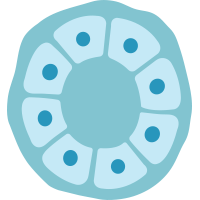
Mammary Cell News
Mammary Cell News is an online resource covering the latest research into breast cancer and mammary cells.
miRNA-200c-3p Deficiency Promotes Epithelial-Mesenchymal Transition in Triple-Negative Breast Cancer by Activating CRKL Expression
[Discover Oncology] Researchers found that miRNA-200c-3p was under-expressed and epithelial-mesenchymal transition (EMT)-related genes were up-regulated in TNBC, and miRNA-200c-3p could inhibit cancer cell proliferation, invasion, and the expression of EMT-related genes and proteins in TNBC.
Targeting Resistant Breast Cancer Stem Cells in a Three-Dimensional Culture Model with Oleuropein Encapsulated in Methacrylated Alginate Microparticles
[Daru-Journal Of Pharmaceutical Sciences] Scientists constructed a breast cancer stem cell organoid-like model and evaluate tumorigenicity through targeting the 3D structure with oleuropein.
TMIST Breast Cancer Screening Trial Enrollment Surpasses 100,000
[ECOG-ACRIN Cancer Research Group] The Tomosynthesis Mammographic Imaging Screening Trial (TMIST) has now enrolled more than 100,000 women in the United States and abroad. One of the fastest-growing National Cancer Institute-sponsored trials, TMIST has expanded to 130 participating clinical sites in the US, Argentina, Canada, Peru, Italy, South Korea, and now Thailand.
Targeting EMT Using Low-Dose Teniposide by Downregulating ZEB2-Driven Activation of RNA Polymerase I in Breast Cancer
[Cell Death & Disease] Researchers demonstrated Teniposide as a potent modulator of the epithelial–mesenchymal transition (EMT) program, specifically through an interferon regulatory factor 7 (IRF7)–N-myc and STAT interactor (NMI) mediated response.
A Prismatic View of the Epigenetic-Metabolic Regulatory Axis in Breast Cancer Therapy Resistance
[Oncogene] The authors discuss interconnected epigenetic and metabolic regulatory pathways and then integrate them into an observable cancer metabolism-therapy-resistance axis that may inform clinical intervention.
TRIM58 Downregulation Maintains Stemness via MYH9-GRK3-YAP Axis Activation in Triple-Negative Breast Cancer Stem Cells
[Cancer Gene Therapy] Investigators reported that TRIM58 was underexpressed in TNBC tissues and cells compared to adjacent mucosa tissue, and its downregulation was significantly associated with shorter survival.
Antibody Drug Conjugate Sacituzumab Govitecan Enables a Sequential TOP1/PARP Inhibitor Cancer Therapy Strategy in Breast Cancer Patients
[Clinical Cancer Research] Scientists assessed proof-of-mechanism and clinical feasibility for Sacituzumab govitecan (SG) and talazoparib employing an innovative sequential dosing schedule. In vitro, sequential SG followed by talazoparib delayed topoisomerase 1 cleavage complex clearance, increased DNA damage and promoted apoptosis.
ASS1 Inhibits Triple-Negative Breast Cancer by Regulating PHGDH Stability and De Novo Serine Synthesis
[Cell Death & Disease] Scientists discovered that argininosuccinate synthase (ASS1), a critical enzyme in the urea cycle, directly bound to phosphoglycerate dehydrogenase (PHGDH) and promoted its ubiquitination-mediated degradation to inhibit serine synthesis, consequently suppressing tumorigenesis.
A Novel Preclinical Model of the Normal Human Breast
[Journal Of Mammary Gland Biology And Neoplasia] Investigators described a normal breast explant model utilising a tuneable hydrogel which maintained epithelial proliferation, hormone receptor expression, and residency of T cells and macrophages over seven days.
Synergistic Effects of miR-143 with miR-99a Inhibited Cell Proliferation and Induced Apoptosis in Breast Cancer
[Biotechnology and Applied Biochemistry] The authors investigated the effects of miR-99a and miR-143 in single expression plasmids for breast cancer (BC) inhibition. Upregulation of miR-99a and miR-143 in any of the two selected BC cells inhibited their proliferation and migration rate, and induced apoptosis.
Loss of Tumor-Derived SMAD4 Enhances Primary Tumor Growth but Not Metastasis Following BMP4 Signaling
[Cell Communication and Signaling] Using preclinical models of spontaneous breast cancer metastasis, scientists investigated the impact of SMAD4 on the ability of bone morphogenetic protein 4 (BMP4) to regulate tumor growth and metastasis.
Senescent CAFs Mediate Immunosuppression and Drive Breast Cancer Progression
[Cancer Discovery] Scientists identified a subset of myofibroblast cancer-associated fibroblast (CAFs) that were senescent (senCAF) in mouse and human breast tumors. SenCAFs were present in HER2+, ER+, and triple-negative breast cancer and in ductal carcinoma in situ (DCIS) where they predicted tumor recurrence.
For over a decade, Mammary Cell News has been keeping the global scientific and medical communities informed about the latest research, reviews, and news in the field of mammary tissues. Our editors gather publications on the topic of mammary cell differentiation and characterization, as well as the progression and treatment of breast cancer. We also keep scientists up-to-date on the latest policy changes, job postings, and events.

 Cancer Stem Cell News
Cancer Stem Cell News Cell Therapy News
Cell Therapy News Dermal Cell News
Dermal Cell News Endothelial Cell News
Endothelial Cell News ESC & iPSC News
ESC & iPSC News Extracellular Matrix News
Extracellular Matrix News Hematopoiesis News
Hematopoiesis News Hepatic Cell News
Hepatic Cell News Human Immunology News
Human Immunology News Immune Regulation News
Immune Regulation News
 Intestinal Cell News
Intestinal Cell News Mammary Cell News
Mammary Cell News Mesenchymal Cell News
Mesenchymal Cell News Muscle Cell News
Muscle Cell News Neural Cell News
Neural Cell News Organoid News
Organoid News Pancreatic Cell News
Pancreatic Cell News Prostate Cell News
Prostate Cell News Pulmonary Cell News
Pulmonary Cell News
